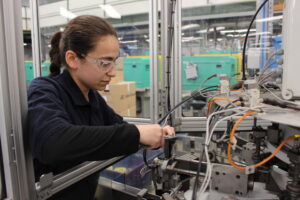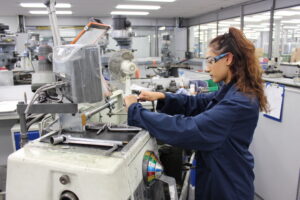Within the last 15 years, there has been a significant increase in women taking job roles in technical industries, improving representation and stigma associated with a career in STEM.
David Jones, Early Careers Specialist at RWC – EMEA, discusses what’s changed in the last couple of decades and highlights how the plumbing and heating industry can continue encouraging more women in STEM.
It’s well documented that women have been substantially underrepresented in STEM industries (Science, Technology, Engineering and Mathematics) due to several historical influencing factors. However, as women begin to expand further into male-dominated industries including the plumbing and heating industry, companies need to be ready to adopt and encourage female uptake of STEM roles.
The reasons for the historically low representation of women are far-reaching and extensive. However, the most cited in recent years – and arguably the most prominent reason – is the lack of female role models within STEM.
Gravitating interests and aspirational goals based on role models is how most of us find passions and purpose in what we do. With comparatively fewer women celebrated or represented for STEM achievements than men, there haven’t been as many examples to lead the next generation.
On top of this, stigma and stereotyping has played a crucial role in the study of STEM subjects. In a study titled ‘Why so Few?’ it was found that girls’ achievements and interests were directly shaped by the environment around them.
To illustrate this, the study instructed teachers to offer frequent encouragement to help expand their experience and learnings, which consequently led to girls performing far better. By adopting a ‘growth mindset’, teachers and parents were able to improve girls’ achievements in maths and science – leading to greater interest in pursuing a future role within STEM.
Apprenticeships
Since then, there has been substantial progress in women working in STEM roles; breaking historical convention and proving women can play an equal role in progressing these industries.
However, while there’s currently over 1 million women working in core STEM roles (with 2019 figures highlighting a particular increase between 2015-2019), women still only make up 24% of the globe’s STEM workforce.
To continue the uptake of women starting a career in STEM, companies and education providers need to work in unison to allow for better representation within industries. One proven way this can be achieved is through apprenticeships.
Apprenticeships offer real-world experience that is often difficult to replicate, while also providing a platform to apply educational teachings in controlled environments. For young women, this presents a great opportunity to explore new skills and get hands-on experience within STEM roles, alleviating the jump between education and employment.
Alongside this, apprenticeship schemes offer a secured career path specifically designed to grow and nurture apprentices into specific roles, offering opportunities to progress in organisations that truly value honed knowledge and skills.
Rising talent at RWC
Recognising the importance of women working in STEM roles, RWC believes competitive apprenticeships should be widely available to help continue boosting numbers of women working in more technical roles.
Looking to pursue engineering roles at RWC, Teah Bernard and Nushra Khodabux are both apprentices that were drawn to the hands-on approach that RWC’s apprenticeships offered.

Similarly, Nushra, who is training in toolmaking as a Toolmaking Apprentice, was introduced to the scheme while attending college.
When asked what they love about their roles, both noted the wide and varied aspects of their work, allowing them to experience multiple parts of the business and broaden their understanding of the plumbing and heating industry.

Teah states: “Due to the vast number of opportunities available in the engineering sector and the company itself, I hope to learn more about the different options available as I progress through my apprenticeship and become specialised in a given field”
With multiple career paths available, it isn’t essential to work directly within a STEM role to contribute to the wider industry. Lucy Morgan and Aimee Thompson, for example, are apprentices at RWC working within HR, utilising their skills to help strengthen RWC’s internal processes.
Both highlighted how they wish to expand their skills at RWC despite being in different stages of their careers. Aimee is looking to gain a CIPD qualification and membership while having worked as a HR Apprentice since January 2021. Lucy, on the other hand, is a HR Associate, undertaking a level 5 HR Consultant/Partner Standard after having been at the company for two years.
The vital functions both Lucy and Aimee carry out at RWC highlight the importance of increasing women in STEM through wider key roles in businesses, especially alongside the technical positions more often associated with STEM.
“Having been at RWC for over four years, and then starting my apprenticeship two years ago, I can say that my experience so far has been a very supportive.,” said Lucy. “Working alongside a number of talented colleagues, I have been able to learn while also contributing towards various projects since the scheme began.”
Looking ahead
The STEM industry has made huge ground in recent years to improve the diversity of its workforce, but more work can still be done. At an educational level, higher advocation for women in technical roles needs to be supported by both educators and companies alike.
Businesses looking to support and encourage female apprenticeships should consider hosting lectures and seminars with students, demonstrating the promising career routes available other than pursuing higher education.
As well as this, businesses should research what is important to young aspiring females looking to enrol in apprenticeship schemes. In their interviews, Teah and Aimee acknowledged that their choices in working for RWC were influenced by its long-term sustainability goals and influence. This has been a common concern amongst millennials, with a study finding that 40% of millennials have chosen a job because of the company’s sustainability agenda.
With this in mind, companies need to consider how they market their business to young female students. Businesses should voice the improvements the plumbing and heating sector is making to drive green practices. This includes celebrating innovation and R&D, with the development of high-quality plastic push-fit fittings that provide inherently long product life cycles, as well as green initiatives like RWC minimising single-use plastic in shipping, and continually integrating more sustainable materials into design.
In a period of rapid change and the adoption of new technology, the plumbing and heating industry can provide a level of stability for young female apprentices given the demand for skills and a shortage of tradespeople.
While the future of the industry will continue to evolve with greater digitalisation and automation, there will be continued dependence on the experience and knowledge of industry experts to manage and maintain future plumbing and heating systems, and women can rightly be a big part of this.
To find out more about what apprenticeships are available at RWC, please visit www.rwc.com
















